|
The «Kitsos Makris Folk Art Center» was donated to the University of Thessaly Library by his family after Folk Art historian Kitsos Makris (1917-1988) passing away. Since 1997 it is one of the Library and Information Centre's branches aiming at organizing and providing access to the Center's collection.
|
|
Information about: |
|
 Contact details (address, phone, e-mail etc.) Contact details (address, phone, e-mail etc.)
 Opening Hours Opening Hours
|
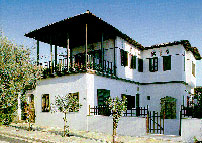
Kitsos Makris Folk Art Center |
|
Γρήγορη μετάβαση σε: |
|
 Kitsos A. Makris CV Kitsos A. Makris CV
 The Building The Building
 The Folk Art Collection The Folk Art Collection
|
|
|
|
|
Kitsos A. Makris short CV
Kitsos Markis dedicated his life in studying Greek folk art and culture. For a more detailed CV please visit the web page: " Kitsos Makris CV" 
|
|
|

|
|
|
The Building
|
The Kitsos Makris house was designed by the architect Argiris Philippidis and built in 1955. The two-storey 180m2 building is a typical example of a house inspired by the local architecture of Mt. Pelion, in which traditional features have been reformed and harmoniously embodied in a contemporary architectural creation. On the ground floor one finds the Folk Art Collection, the study and the living-room, while the bedrooms and the bathroom are located on the upper floor.
|
|
The study, a small room full of books, photographs and souvenirs, was Kitsos Makris' favorite place of work and creation. Because of this, it was decided to preserve the special atmosphere and character that he gave to his «private» room
|
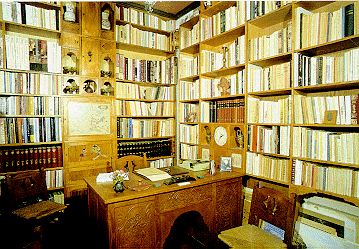
Kitsos Makris' study room
|
|
The living room resembles a «doxato» room of Pelion with a wooden arch and a superb 18th century ceiling removed from the Banti House in Drakia before its demolition. High on the wall of the living room (friza) Kitsos Makris painted Volos and Pelion «...not in the way the eyes see them but as he always carries them in his heart...». In the same room there is a showcase in which Kitsos Markis' photographs, pictures, books and awards he received are displayed.
|
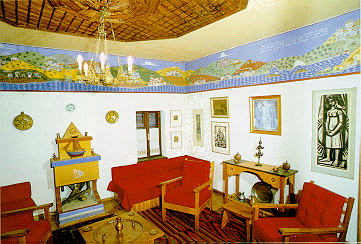
The living room
|
|
|
|

|
|
|
The Folk Art Collection
|
The Folk Art Collection consists of 560 items, mainly from the Pelion area, dated back to the 18th and 19th century. Some of the exhibits are considered unique, such as the large wall painting by Pagonis dated from 1832 portraying the little house (paraspito) of the Triantafillou Mansion located at the Drakia village in Mt. Pelion. Pagonis also painted Greek towns and villages like Chalkida, Talanti, Douki, etc.
|
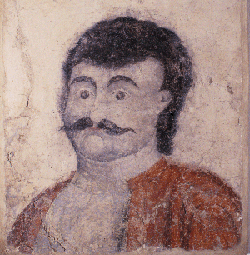
"Rigas Feraios" wall painting by Athanassios Pagonis (son) 1870
|
|
There are also wall paintings by Athanassios Pagonis, son of the previously mentioned artist, dated from around 1870 depicting landscapes of Thessalian plains. The same artist has also created one of the most important folk portraits, that of "Rigas Feraios", which is also included in the collection.
|
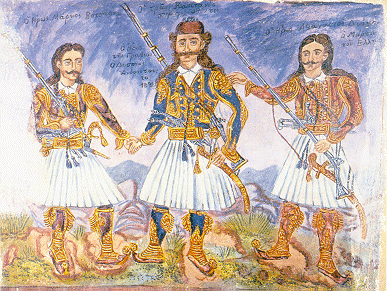
«Three Reconciled Chiefs» wall painting by Theophilos Hatzimichail, 1898
|
An outstanding part of the collection are the 25 paintings by Theophilos Hatzimichail, who lived in the area of Magnesia from late 19th century till 1927 when he returned to Mytilini, his birthplace. Some of his best-known paintings are included in the collection such as: «The Newly-Wed», «Three Reconciled Chiefs» and «Greeting May», as well as some of his icons, the most important of which is the «Infant-carrying Holy Virgin».
|
The last local folk painter Nikolaos Christopoulos (1880-1967) is also represented in the collection with 19 paintings illustrating his typical ships and sailing theme.
Of particular interest is a collection of paper icons printed from copperplate engravings made in the monastic laboratories of Mount Athos (The Holy Mountain) and distributed by traveling monks.
|
|
|
|
|
|









 Printer friendly version
Printer friendly version

 Printer friendly version
Printer friendly version





